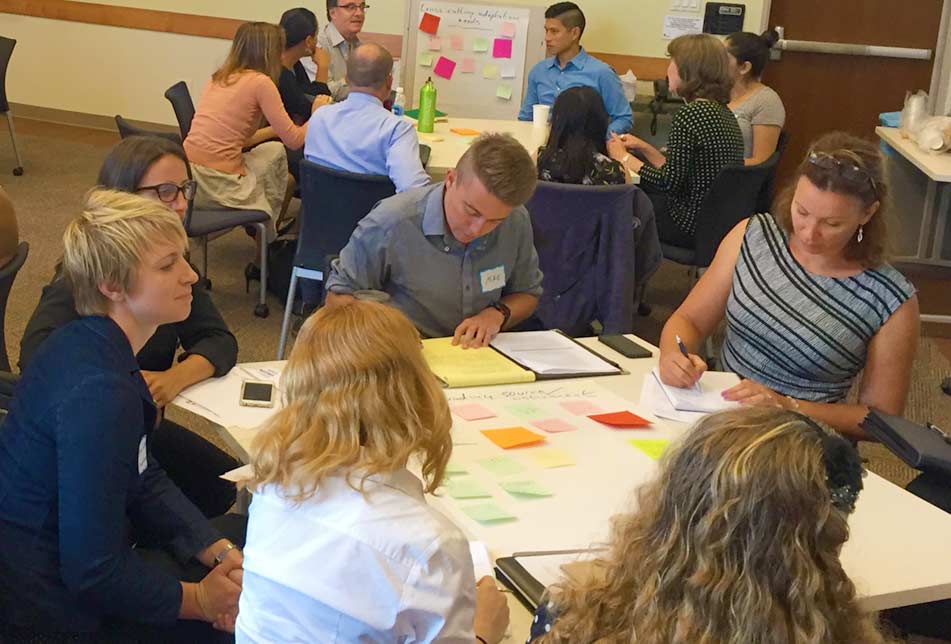Through our work with California local governments, we identified two emergent trends that local governments are prioritizing and grappling with.
Emergent Trends for Local Governments in 2017

Earlier this year, the Statewide Energy Efficiency Collaborative (SEEC) released the State of Local Climate Action: California 2016. In this report, SEEC partners highlight five case studies and statewide analyses of local government progress on conducting greenhouse gas inventories, setting emissions goals, developing plans, implementing policies and programs, and demonstrating leadership through municipal emissions reduction. Not surprisingly given the history of local climate action in California, local governments continue to employ innovative strategies to meet locally-defined goals, as well as to play their part to help achieve ambitious State goals.
While the sheer breadth of local action and progress is both impressive and encouraging, expectations and requirements for local governments are growing at an unprecedented rate without a proportionate increase in available funding opportunities. Local governments will need to be more creative than ever in developing partnerships, securing funding, and revamping institutionalized practices to create truly vibrant and livable communities.
Through our work with California local governments, we identified two emergent themes that local governments are prioritizing and grappling with. This article aims to highlight a few best practices, strategies, and resources to help get your agency started on:
- Elevating the voice of vulnerable communities, and
- Long-range planning in an uncertain future.
Elevating the Voice of Vulnerable Communities
In recent years, the disproportionate environmental risks and burdens faced by some communities, particularly low-income communities of color and vulnerable populations, has increasingly become of concern. In part as a result of effective advocacy giving voice to disenfranchised communities, policymakers, planners, and practitioners have been more intentionally looking at how we can ensure that the transition toward a low-carbon, climate-resilient future is accessible, inclusive, and people-centric.
Several bills from the 2016 legislative session reflect this more direct consideration, and take up these concerns. Over time, these bills will influence how communities respond to climate change or access funding.
- SB 1000 (Leyva) will require cities and counties to incorporate environmental justice in their general plans by identifying objectives and policies that reduce the health risks in disadvantaged communities, promote civil engagement in the public decision-making process, and prioritize programs that address the needs of disadvantaged communities.
- AB 197 (Eduardo Garcia) will generate rules and regulations that result in direct emission reductions at large stationary sources and from mobile sources to protect the state’s most vulnerable and disadvantaged communities. AB 197 also directs the state to develop and consider the “social costs” of carbon in its calculations of impacts and benefits, which specifically includes an estimate of economic damages, changes in net agricultural productivity, impacts to public health, climate adaptation impacts, and changes in energy system costs per metric ton of greenhouse gas emission per year.
- AB 1550 (Gomez) allocates a minimum of 25% of the Greenhouse Gas Reduction Fund to fund projects located within, and benefitting individuals living in, disadvantaged communities, as well as a separate minimum of 20% to projects that benefit low-income households.

These bills elevate the consideration of equity and justice into local policymaking and planning processes in ways that provide opportunities to genuinely engage community members to prioritize programs and projects that will yield tangible benefits to those in need. However, this push may not be easy or straightforward, and local governments will be looking for support and guidance. Some of this may come through state agencies (e.g. General Plan Guidelines or AB 32 Scoping Plan), however, the environmental justice (EJ) movement has developed resources and strategies that can be looked at along the way to better prioritize EJ and equity.
- Working with executive leadership and agency department heads, and updating organizational goals and plans accordingly, to prioritize equity and EJ. Some examples include:
- Creating an EJ framework and targeted goals to communicate your agency’s commitment to staff and the public, as well as to serve as a valuable resource for staff to reference.
- Bringing in local EJ experts to provide core training to staff can help build ownership and commitment from the ground up and raise the baseline understanding for equity and justice. Such trainings can also serve to demonstrate commitment from agency leaders in prioritizing equity and justice.
- Embracing and celebrating diversity by regularly reviewing and improving hiring practices, retention rates, and office culture can bring a multitude of benefits to your organization and community. A diverse staff reflective of the community can help to establish trust and foster creativity, collaboration, and empathy within your agency.
- Partnering with local EJ organizations, community-based organizations, direct service providers, and neighborhood associations to assess concerns, needs, and vulnerabilities can ensure that your agency develops needs-based policies and plans that avoid top-down, prescriptive measures.
- It is important to recognize that these groups have limited funding. Providing funding to allow and encourage equity and justice organizations to engage in the planning process can demonstrate that your agency values their engagement, the important role that they play in their community, and the invaluable perspective that they bring to the table.
- Additionally, local agencies should approach these partnerships with a high level of openness and understanding. Acknowledging that their perspective is both valid and valuable, and that their grievances are legitimate, both rooted in personal experiences and aggravated from a history of being disregarded, will help build mutual trust.
- If these types of organizations are not prevalent, your agency can empower community members by connecting individuals to funding, employment, and/or training opportunities.
- Employing strategies for meaningful community engagement can increase participation from the community by overcoming barriers to participation
- Some barriers to participating in in-person meetings include lack of access to affordable transportation and child care, as well as financial and work schedule constraints. For online engagement, some barriers include lack of access to Internet and required technology, as well as limited technological literacy.
- A well-established best practice is to meet stakeholders where they are, rather than asking them to come to you. From community colleges to neighborhood block parties, local agencies can leverage many opportunities to engage their residents.
- Clear, concise, and convenient opportunities (e.g. brief interviews and surveys structured like games) can make it easier for community members to engage in the planning process. It is important that the language used – both verbal and written – is easy to comprehend and does not use jargon or technical terminology without definitions.
Long-Range Planning in an Uncertain Future
In addition to considering equity and disadvantaged communities, it is increasingly clear that climate change will force local governments to consider future risks and impacts as opposed to looking to the past for guidance. The uncertainty of climate science with respect to the extent, scale, and timeline of how different impacts will emerge and be experienced further complicates effective planning. Such a shift requires a new degree of comprehensive long-range planning that takes into account emergent vulnerabilities and risks to infrastructure, public health and safety, water quality and supply, ecosystem services, the local economy, and all other sectors.

The State has renewed its commitment to integrated and comprehensive planning – for state agencies and local governments alike. This is evident in recent legislation:
- AB 2800 (Quirk) requires state agencies to take into account the expected impacts of climate change when planning, designing, building, and investing in state infrastructure.
- SB 1386 (Wolk) declares it to be the policy of the state that the protection and management of natural and working lands are a key strategy in meeting the state’s GHG reduction goals.
- AB 2722 (Burke) creates the Transformative Climate Communities Program with the intent to demonstrate how private resources can be more effectively catalyzed to support innovative community and climate transformation in disadvantaged communities through comprehensive planning and implementation.
- SB 246 (Wieckowski) creates the Integrated Climate Adaptation and Resiliency Program to coordinate state, regional, and local efforts.
- SB 379 (Jackson) requires local governments to include climate adaptation and resiliency strategies in their general plans or hazard mitigation plans.
While grappling with uncertainty and integrating additional considerations into planning is not an entirely new challenge, climate change is accelerating. This entails unprecedented levels of uncertainty and of the potential impacts to the status quo. To effectively adapt, cities and counties will need to reconsider how they assess and account for risk, and create internal processes and systems that foster creativity and collaboration.
Comprehensive planning can be challenging, but it also has clear benefits. A comprehensive approach to planning and implementation can display aggregated results, which can be perceived more clearly and positively by the public. This can help generate new public-private partnerships, engage local elected officials, and attract new funding opportunities and investments. Some helpful considerations and strategies include:
- Supporting Workforce Transition to help your community adapt to a changing future.
- As one industry or position dwindles, another takes its place. Many existing jobs are or will be threatened by automation, technological advancements, and/or shifting consumer demands. Developing relationships with industry experts and local businesses will help your agency anticipate changes in order to structure workforce development programs appropriately.
- Connecting a workforce development program to community goals can serve a dual-purpose to help your agency reach these goals and to provide meaningful employment for residents to work in the community they live in. Impact-driven industries and fields that can be supported by workforce development programs include renewable energy, green infrastructure, ecosystem restoration, water reuse and recycling, adult education, and human services (e.g. homeless shelters, rehabilitation centers, and food banks).
- Additionally, investing in staff training can increase capacity and take your agency to higher levels of coordination, management, and planning capabilities.
- Developing multi-benefit planning criteria to ensure that, despite uncertainties, limited resources are invested for optimal outcomes across the community. For example:
- A zero net energy community center with public meeting spaces can serve multiple purposes including showcasing technology and energy efficiency practices to encourage zero net energy implementation, providing communal meeting spaces to increase social cohesion, and serving as an emergency shelter during extreme heat and weather events.
- Urban forestry can increase energy efficiency, reduce the urban heat island effect, sequester carbon and improve air quality, and discourage criminal activity.
- Anticipating technological advancements can ensure that plans remain flexible and responsive to incorporate new technologies and approaches.
- Renewable energy, electric vehicles, and the rise of the sharing economy have already demonstrated that cities and counties need to make smart planning and investment decisions in order to respond to the demands and desires of their residents and visitors, as well as to address the secondary impacts of these demands such as to the electric grid and jobs shifting from one industry to another.
- Local agencies should also consider autonomous vehicles, microgrids and storage, and the Internet of Things to avoid making unnecessary and costly investments, such as widening roads.
Julia Kim | Local Government Commission
Local Government Commission Newsletters
Livable Places Update
CURRENTS Newsletter
CivicSpark™ Newsletter
LGC Newsletters
Keep up to date with LGC’s newsletters!
Livable Places Update – April
April’s article: Microtransit: Right-Sizing Transportation to Improve Community Mobility
Currents: Spring 2019
Currents provides readers with current information on energy issues affecting local governments in California.
CivicSpark Newsletter – March
This monthly CivicSpark newsletter features updates on CivicSpark projects and highlights.



